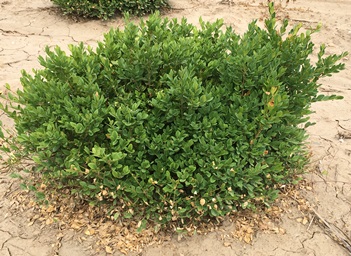 Boxwood blight was found in Wisconsin for the first time in July 2018 at a nursery growing operation. The nursery staff cooperated with Department of Agriculture, Trade and Consumer Protection (DATCP) inspectors on efforts to eradicate and limit spread of the disease. A fungus called Calonectria pseudonaviculata causes boxwood blight. Since 2018, it has also been found in several residential and commercial landscapes in multiple counties across the state.
Boxwood blight was found in Wisconsin for the first time in July 2018 at a nursery growing operation. The nursery staff cooperated with Department of Agriculture, Trade and Consumer Protection (DATCP) inspectors on efforts to eradicate and limit spread of the disease. A fungus called Calonectria pseudonaviculata causes boxwood blight. Since 2018, it has also been found in several residential and commercial landscapes in multiple counties across the state.
The fungus affects all cultivars of boxwood, although some cultivars are more susceptible than others. It also affects Pachysandra terminalis and Pachysandra procumbens, commonly known as Japanese spurge and Allegheny spurge, respectively.
The disease first appeared in the mid-1990s in the United Kingdom and has now spread throughout Europe. It first appeared in the United States in 2011 and has now spread to more than 2 dozen states. We don’t know how it was introduced to the U.S. or to Wisconsin.
There are no treatments to cure boxwood blight. Destruction of affected plants is necessary to control the disease. Preventive treatments may be available.
Nursery growers and dealers, landscapers and homeowners need to be on the lookout for this disease.
 Symptoms
Symptoms
Defoliation is the most obvious sign of infection with boxwood blight. This might start with one or a few plants, but it can spread rapidly to others. Plants develop brown leaf spots, often with dark borders, and the spots grow and coalesce. Leaves drop off, often soon after these leaf symptoms appear. The stems of infected boxwood show dark brown to black lesions, often in a diamond-shaped pattern.
Don't confuse boxwood blight with winter kill. In Wisconsin, we see a fair amount of winter kill in boxwood, but the dead leaves usually stay on the shrub.
Pachysandra cultivars develop brown spots on the leaves.
Reproductive spores are visible on the underside of leaves and on stem lesions.
Transmission
Boxwood blight most often spreads to new areas by moving infected plants. It can also be transmitted on clippers and pruners, shovels, and other garden equipment, and on gloves, clothing and even vehicles. Plants that are less susceptible may carry the disease without showing symptoms, as can plants treated with fungicides, which may mask symptoms. C. pseudonoviculata spreads rapidly in warm, humid conditions.
Control
There are no curative treatments for boxwood blight. Once C. pseudonaviculata is present, symptoms are merely suppressed with fungicides. Uninfected plants can be sprayed prophylactically with fungicides to prevent infection. Infected plants must be dug out with the roots, and leaf litter collected. All the plant material must be burned, buried at least two feet deep, or double-bagged and landfilled. The spores may exist in the soil for up to 6 years, so do not plant susceptible cultivars there for at least that time.
Best Management Practices
To prevent introducing boxwood blight:
Purchase plants from reputable suppliers, nurseries or garden centers, and carefully inspect plants and cuttings for symptoms.
Purchase cultivars that are less susceptible.
Isolate new plants or rooted cuttings from existing boxwood/pachysandra plantings or production areas for at least a month, and preferably several months.
Space plants adequately to maximize air circulation and minimize conditions favoring disease development.
Avoid overhead watering, and avoid working with plants when they are wet, because this may spread the pathogen if it’s present.
Rake and remove boxwood leaf debris as, once introduced, the fungus may survive in the soil up to 6 years.
Inspect boxwood plants frequently. For nurseries and garden centers, this means daily or weekly.
When conditions favor development of boxwood blight, consider fungicide treatments as a preventive measure. Fungicides will not cure boxwood blight, and may actually mask symptoms, so use them carefully. Be sure they are labeled for use on boxwoods (or Pachysandra cultivars), and always follow label instructions.
Do not use boxwood holiday decorations near boxwood in your landscape.
Dispose of boxwood holiday decorations in sealed plastic bags and send it to the landfill. Do not compost the greenery.
If you suspect boxwood blight:
If boxwood blight is confirmed:
Promptly remove any diseased plants and leaf debris.
Dispose of all plant material by:
Do not replant the area with susceptible boxwood cultivars since spores persist in the soil for 5-6 years.
Partially resistant boxwood could be planted, but you will need repeated fungicide applications to protect them from becoming infected by any lingering fungal spores.
Highly resistant boxwoods will not require fungicide treatment.
Back to Regulatory Pest and Diseases page